
This page created 1997, updated 12th June 2019
The Roof-Box STLs, STL 1614-2647 (Total 1034)

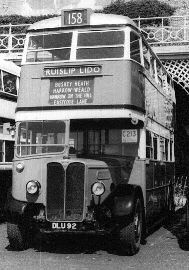 The first toy I can ever remember receiving was a Dinky toy STL,
that Dad gave me one Saturday morning when I was about 3 or 4,
i.e. in about 1951-2. It made an impression.
I still have it, sitting on my study shelf.
I expect many children's interest in buses was stirred by these fairly crude,
but still recognisable models, in their red and cream, or green and cream colours.
The first toy I can ever remember receiving was a Dinky toy STL,
that Dad gave me one Saturday morning when I was about 3 or 4,
i.e. in about 1951-2. It made an impression.
I still have it, sitting on my study shelf.
I expect many children's interest in buses was stirred by these fairly crude,
but still recognisable models, in their red and cream, or green and cream colours.
The prototype was the roofbox STL.
From the latter part of 1936 until 1939 London Transport built these
as their standard double decker. Their most obvious distinguishing characteristic
was the route number display mounted on the front dome, with the final destination
and via points in symmetrical displays between the decks.
STL 2093 (DLU 92), in preservation, at Brighton.
Click on the image for a larger, clearer version.(Above right) Roofbox STL, pre-war livery.
Photo, used with permission, by BusSpotter

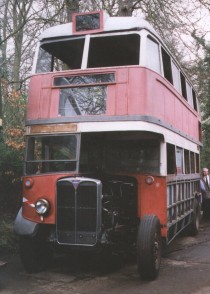
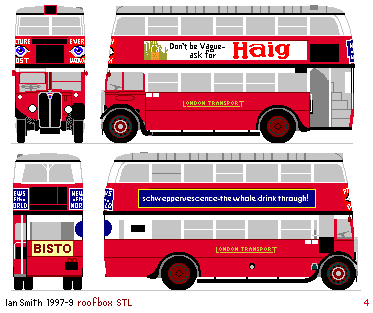
STL 2377 back in the sunshine after a thorough mechanical overhaul
awaiting its body restoration at Cobham Museum, on the Open Day
in April 1998. Photo by Ian Smith. Click for larger version.

STL 1614-2013 Chiswick Roof-box STLs (Total 360)
The roofbox STLs evolved during their build. There were initially two variants of the body,
with steel floor (STL12) or with traditional wooden floor (STL14).
The chassis were mostly 4/9STL, with the Comet MkIII oil engine,
but a handful (at first) tried out a new engine, the A182 toroidal direct-injection 7.7 litre oil engine.
These were classified 5/9STL, (STL 1642, 1654, 1657, 1661, 1668, 1670).
They were built by Chiswick from October 1936 to July 1937. For those good at arithmetic,
who have spotted that the number range is 400 numbers while there were 360 roofbox STLs,
there is good news: the laws of arithmetic have not changed.
The missing forty were the Tunnel STLs, with specially profiled STL13 bodies
for use through the Blackwall Tunnel. These have their own page.
The roofbox STLs started into service in October 1936,
the start of a substantial tide that swept away the last of the NS class
and scattered the smaller STs to the corners of the LT system.
There were hiccups, of course:
the 56-seater STLs replaced 56 seater LTs on route 41, only to be turfed off a month later,
probably due to their higher axle-load over a bridge on the route.
Other non-standard types around the system went too, eg the Dennis Lances at the end of 1937.
The Leyland Titan TD class also started to go in 1938.

STL 2014-2188 Park Royal Roof-box STLs (Total 175) 4/9STL15
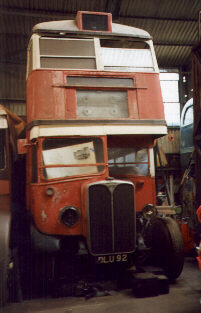
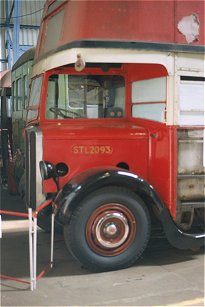 The 1937 replacement programme was so enormous that Chiswick could not legally
build all the bodies required.
So an order was placed with Park Royal Vehicles for
this batch of 175 bodies, and 100 complete buses were ordered from Leyland
(the pre-war STDs).
The STL15s were built using Park Royal's patented metal-framed system,
and looked very similar to the Chiswick-built buses.
Unfortunately these bodies with metal frames did not last long,
due to an unforseen interaction between the metal frames and the glues being used.
They became saggers very quickly, and thus early candidates for re-bodying.
So when the need arose for more lowbridge buses during the war, these figured among
the bodies that were junked to provide chassis for the 20
Wartime low-bridge STL bodies.
The 1937 replacement programme was so enormous that Chiswick could not legally
build all the bodies required.
So an order was placed with Park Royal Vehicles for
this batch of 175 bodies, and 100 complete buses were ordered from Leyland
(the pre-war STDs).
The STL15s were built using Park Royal's patented metal-framed system,
and looked very similar to the Chiswick-built buses.
Unfortunately these bodies with metal frames did not last long,
due to an unforseen interaction between the metal frames and the glues being used.
They became saggers very quickly, and thus early candidates for re-bodying.
So when the need arose for more lowbridge buses during the war, these figured among
the bodies that were junked to provide chassis for the 20
Wartime low-bridge STL bodies.
Those that did survive the war were in very poor condition, occasioning the
urgent loan of new Bristol buses from other companies,
and also the SRT programme, where these chassis received newer STL16 bodies,
while the chassis of the STL16s were modified to take new RT bodies.
This happened at the end of 1948 / early 1949, the sagging Park Royal bodies being scrapped.
STL 2093 undergoes a further round of restoration at Cobham.

STL 2189-2515 Chiswick Roof-box STLs (Total 327)
Chiswick built a further batch of roofbox buses between June 1937 and March 1938.
These were essentially identical to the previous examples,
and again comprised a mix of flooring: steel (4/9STL12) and wooden (4/9STL14/1).
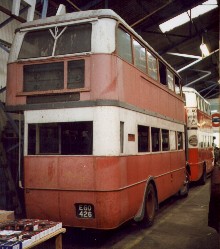
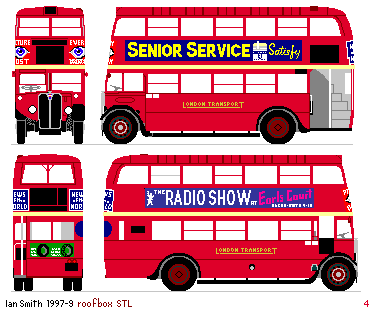
STL 2377 in the shed at Cobham Museum, autumn 1997,
awaiting its turn for restoration.
STL2377 is one of the second batch of Chiswick roofbox buses, classified
4/9STL14/1, starting work for London Transport in
November 1937 at Holloway garage (J).
During the war they received the usual reduced displays, brown roofs,
masked headlights and anti-shatter netting. Some received far nastier things too.
Like the other Chiswick roofbox STLs these lasted well,
and continued after the war while the later war-time and immediate post-war
classes were disposed of.
Three were the subjects of body experiments: two were converted for
Pay as You Board Experiments,
and one received the very last STL body built, the prefabricated parts
Sainsbury Body.
Most of the others were repainted into one or both of the post-war liveries
of red with cream relief,
either round the upper windows plus a band round the middle,
or the later version with just the cream band.
Appreciable numbers went to the Country Area after the war,
where rapid growth in traffic required unprecedented numbers
of double-deckers on routes that had been rural and were now outer suburban.
Some succumbed to the SRT fiasco,
but others survived until 1953-4 before being taken over by the ubiquitous RT.
One survivor, STL2377, has been throughly restored, with renewed framing and panelling:
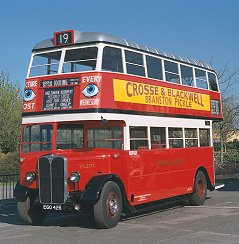
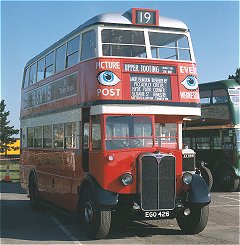
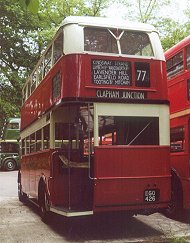
STL 2377 after restoration, at the Cobham Open Day at Brooklands Runway, April 2002,
with newly-painted period advertisements, and earlier at Cobham Museum, without ads, in June 2001.

STL 2516-2647 The Ultimate STLs (Total 132) 15STL16
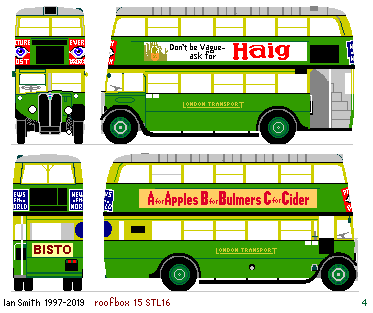
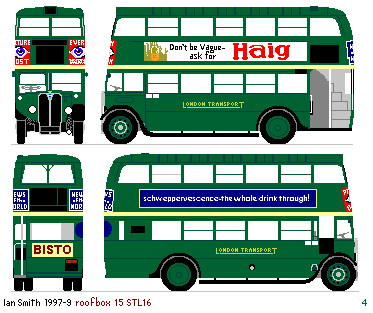
These were the final main development of the STL design, before attention
switched away to the
RT.
They were distinguished by a new deeper radiator,
without a protruding starter dog, due to the flexible mounting of the 7.7
litre diesel engine.
They were also given wheel hub-cover discs, at both rear and front.
For the first time, new highbridge rear-platform STLs (37) went to the Country Area.
The first build was divided between Hanwell and Northfleet, whereas the second batch were more widely distributed, going to Alperton as well as Hanwell for the Central Area, and Dartford for the Country Area. The Country buses, along busy Thames-side, replaced Northfleet's tired TDs and front-entrance STLs (which had a much smaller seating capacity). These latter were redistributed around the system, displacing more TDs at Windsor. Dartford lost STs.
The last of these new buses entered service in September 1939, into a new world of war. All received grey or brown roofs, white patches on mudguards and corners, white spots on the rear, reduced lighting inside and out. The bodies stayed on the chassis they had started on - except for one pair that swapped and a couple of casualties that received earlier replacement bodies.
Some of the new buses were dedicated to Green Line work, and painted accordingly.
In July 1948 there seems to have a concerted effort to return the Hanwell originals from various garages back to Hanwell.
After the war these buses might have been expected to have a long life.
But someone had a stroke of genius that just went wrong,
resulting in a premature end for these fine buses.
The idea was to use the STL16 bodies to replace the decrepit Park Royal bodies
on older chassis,
while the young 15STL chassis would have the benefit of new technology with RT bodies!
The chassis were dismantled, shortened, straightened, plugged and redrilled to take the new bodies.
Unfortunately the engines proved underpowered for the heavier body (only 7.7 litre, rather than 9.6!),
and, perhaps worse, the brakes were inadequate to cope with the extra half-ton!
As a result, these SRTs were soon rebuilt with RT chassis,
and the relatively young but bodiless 15STL chassis found no buyers.
Those that stayed as STLs lasted until 1953-4.
One of the displaced bodies went on to STL2093, which was preserved and is now in the London Bus Museum at Brooklands, awaiting restoration but displayed in a delapidated state as "a Blitz victim".

 the roofbox bus histories
the roofbox bus histories
 photographic references
photographic references

 Bus Stop
Bus Stop
 contents
contents
 ex-Daimler
ex-Daimler
 Roofbox
Roofbox
 Tunnel STLs.
Tunnel STLs.
|

 The first toy I can ever remember receiving was a Dinky toy STL,
that Dad gave me one Saturday morning when I was about 3 or 4,
i.e. in about 1951-2. It made an impression.
I still have it, sitting on my study shelf.
I expect many children's interest in buses was stirred by these fairly crude,
but still recognisable models, in their red and cream, or green and cream colours.
The first toy I can ever remember receiving was a Dinky toy STL,
that Dad gave me one Saturday morning when I was about 3 or 4,
i.e. in about 1951-2. It made an impression.
I still have it, sitting on my study shelf.
I expect many children's interest in buses was stirred by these fairly crude,
but still recognisable models, in their red and cream, or green and cream colours.











 the roofbox bus histories
the roofbox bus histories Bus Stop
Bus Stop contents
contents ex-Daimler
ex-Daimler Roofbox
Roofbox